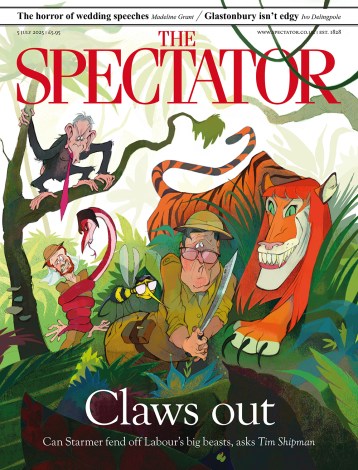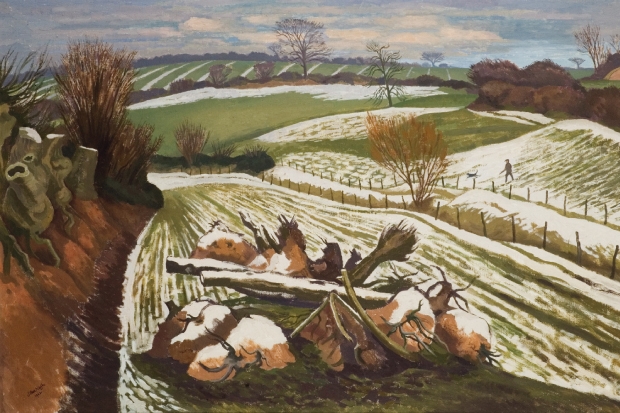In owning a flock of artificial sheep, Joseph Farquharson must have been unusual among Highland lairds a century ago. His Aberdeenshire estate covered 20,000 acres — surely enough to support the modest local ovine needs. But Farquharson was a painter, the fake sheep artist’s models. For cleanliness and biddability, few grazing ewes can match a woolly dummy.
Joseph Farquharson was 27 when he scored his first hit at the Royal Academy in 1873. ‘Day’s Dying Glow’ depicts a handful of sheep negotiating a snowy incline alongside an icy burn. Leafless trees crown a mound. Behind them a sickly sun is sinking or possibly rising. It is an image of some technical proficiency, which a Victorian audience, versed in reading paintings as visual narratives, could just about imbue with meaning and sentiment.
Farquharson evidently enjoyed the experience. For the next half-century, he reworked that first glistening vignette, alternating dusk with dawn, adding or subtracting trees, incorporating a shepherd, piling his snow thicker and thicker, and pillaging Burns or Milton for suitably evocative titles. In her bestselling Scottish diary extracts, Leaves from the Journal of Our Life in the Highlands, with its account of John Brown’s handiness and her own fondness for picnics, Queen Victoria had already branded Aberdeenshire a region of rugged romantic possibility. Farquharson’s paintings reimagined its winter landscape as a tingling, sheep-filled Eden.
Today, unsurprisingly, Farquharson’s work is held in high esteem by manufacturers of Christmas cards. His opalescent washes of sunlight on snow are still impressive in their painterly dexterity. His artificial sheep look appealingly real (albeit too clean); his vision is the pictorial equivalent of ‘In the Bleak Midwinter’. But blink, or stare too intently, and it’s hard not to conclude that, like much Victorian pontificating, Farquharson’s paintings — which earned him the nickname ‘Frozen Mutton’ Farquharson — say remarkably little. Adept they may be: profound, no.
That sense of something lacking characterises much ‘snowy’ art. It’s as if the technical challenges of recording the fluffy white stuff convincingly are so debilitating, there’s no room left for inspiration. For Dutch artist Hendrick Avercamp, who painted landscapes teeming with ice-skaters early in the 17th century, unusual climatic conditions liberate a holiday spirit among his stolid burghers. Avercamp’s snow is theatrical backdrop, much as in the ballet Les Patineurs, and every bit as tinselly. Invigorated by the freeze, his skaters do not reflect on the irony that what temporarily quickens their pulses is itself a deadening force: trees stand black-branched, birds wheel in search of non-existent food. Later in the century, Dutch landscapists explored the stillness snow imposes, sometimes by moonlight. Such scenes invite reflection, as if the association of snow and Christmas were firmly established 400 years ago, the snow a metaphor for the physical hardships of the Nativity. Alternatively these images may simply be exercises in tonality, like the later wintry cityscapes of Childe Hassam.
Monet painted more than 100 snow paintings, including ‘The Magpie’ of 1868–9, Argenteuil views and, inevitably, soggy haystacks. Several surprise on account of the breadth of the artist’s palette. Snow proved an ideal foil for ‘impressions’ of light, sunshine that is pink, blue-grey, palest buff or white. Yet, while many successfully capture aspects of the reality of the snowy experience, it is the artist’s prowess, rather than a deeper profundity, that impresses the viewer.
There is a comfortable quality about much of Monet’s snow painting. In this the French artist’s approach differs markedly from that of his North American contemporaries. Nineteenth-century American landscapists such as Willard Metcalf and Walter Launt Palmer invest their winter landscapes with a heroic monumentality. The untamed country they depict — tamed fleetingly by the artist — becomes a reflection of the frontier spirit: bold, vigorous and, yes, just a tad monotonous in its beefy assertiveness. Such images lack the mystique of snow scenes by German romantic Caspar David Friedrich. Romance is not on their agenda.
Of course there are exceptions. ‘The Hunters in the Snow’, painted by Bruegel in 1565, remains a magisterial depiction of a landscape blanketed by snow. A kaleidoscope of human emotion is silhouetted here, from the exhaustion of the returning hunters to the skaters’ joy. People scavenge, toil, exult, in a compellingly powerful image. Easier on the viewer but also moving is a painting of almost 400 years later, ‘Melting Snow at Wormingford’, by John Nash. Nash’s snow-striped field is quintessentially English in its compromise and understatement, yet still remote from the Christmas card world of Farquharson’s paintings. Here, without ostentation, snow inspires that quiet contemplation the season probably deserves.






Comments